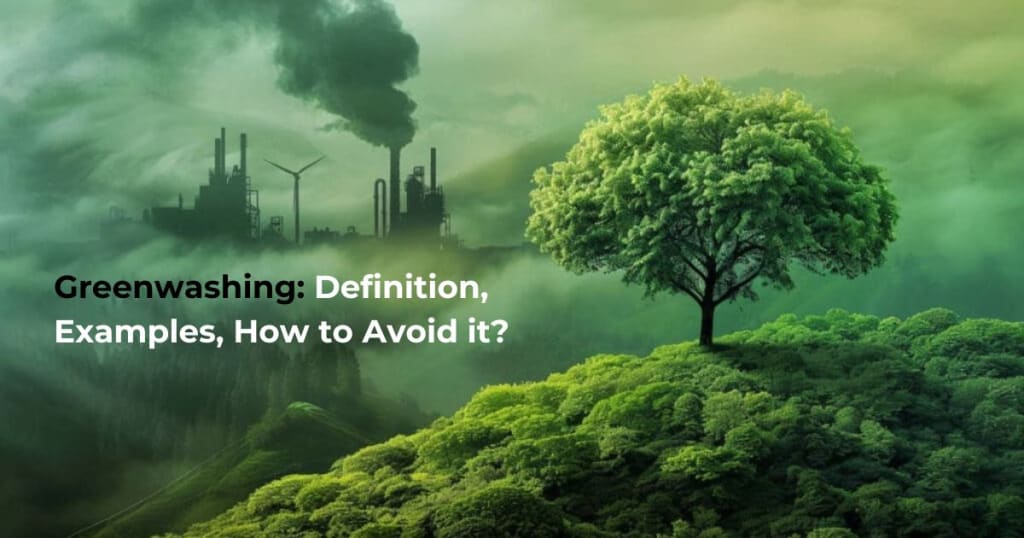Greenwashing: Definition, Examples, How to Avoid it?
greenwashing

Today, consumers and stakeholders expect companies to engage and take environmental issues into consideration in their development strategies. To attract public attention, some companies communicate excessively on these subjects, even to the point of exaggerating their real actions or minimizing the impact that their value chain has on the environment.
This is how we have seen the emergence in recent years of campaigns emphasizing small environmental gestures, unfortunately insufficient to respond to the climate emergency; or even a promotion of compensation strategies, which evade the main question: what actions have these companies actually implemented to actively act in favor of reducing their greenhouse gas (GHG) emissions. This is what we call greenwashing.
To learn more about this subject, Big Media offers you this complete guide, covering the essential points around this practice: what is greenwashing? What do the regulations say about it? What are the strategies of greenwashers? And above all, how to avoid greenwashing?
What is greenwashing? Definition
Greenwashing, also known as eco-bleaching or greening in French, is a concept that appeared in the 1990s and was created by NGOs. Greenwashing is a marketing method that consists of companies using the ecological argument to the public in order to give themselves an eco-responsible image blockchain carbon traceability when the reality is quite different and their practices are far from living up to the claims.
Whoever engages in greenwashing therefore sets up misleading communication which can be, in many cases, assimilated to false advertising. Depending on the arguments used and actions put forward, greenwashing can itself be broken down into different sub-concepts, discussed later in this article.
Greenwashing and green bashing, what’s the difference?
While greenwashing consists of a fallacious use of ecological arguments to improve the image of a company, greenbashing is used to mock and denounce practices deemed excessive, illusory or unrealistic by a company, in particular its communication actions suspected of greenwashing. If the latter is carried out by the company, greenbashing therefore comes from the public who make it known that they are not fooled by the insincere communication of a structure or group.
What does the law say about its practice?
The action of NGOs, which are increasingly actively denouncing the communication strategies of brands suspected of greenwashing, is reinforced by regulations at national and European level.
In France
The Climate and Resilience Act of August 22, 2021 has regulated the use of carbon neutrality claims by companies since January 1, 2023. Companies must now prove the rigor, transparency and honesty of their assessment procedures (carbon footprint, LCA) to claim the carbon neutrality of their products and services. In the absence of tangible evidence and in the event of a proven violation, they are liable to a fine of 100,000 euros.
At the same time, Article L.132-2 of the Consumer Code makes greenwashing a criminal offence if the commercial practice is recognised as misleading. A company found guilty of these acts is thus liable to two years' imprisonment and a fine of 300,000 euros. Note that this fine can be increased to 80% of the expenses incurred for the creation of the advertising or the practice of the established greenwashing.
In Europe
At the European Union level, regulations on greenwashing are in preparation. The Green Claims Directive on greenwashing (2022) obtained a provisional agreement between the European Parliament and the Council of Europe in September 2023. It aims to ban misleading advertising and provide “better product information”.
It will be complemented by the draft of a second measure called the “Eco-Claims Directive”, presented by the European Commission on 22 March 2023.
What are the penalties for environmental allegations?
Both financial and reputational penalties can be severe. Regulatory authorities, such as the Directorate General for Competition, Consumer Affairs and Fraud Control (DGCCRF) in France, can impose substantial fines on offenders. These reprimands are put in place to protect consumers from any misleading advertising and to ensure fair competition between businesses.
How to recognize greenwashing?
Unfortunately, almost every industry has examples of greenwashing. So what does the strategy of companies that practice it look like? How can you recognize greenwashing?
1. Deceive through colors and words
Giving the impression of false ecological responsibility is actually quite simple. Perhaps you have already encountered these scenarios?
Products presented as “green” without any explanation to support this argument.
Cleaning products marketed as “natural” without details on actual ingredients or manufacturing processes.
Greenwashing in the automotive sector. The concept of a “clean car” without taking into account the real environmental impacts of electric or hybrid vehicles (rare earths used for batteries, end of life of components, etc.).
The promotion of products that claim to be “sustainably farmed” or “environmentally friendly” but that in reality come from intensive agricultural practices with excessive use of pesticides or leading to deforestation…
All this has a name: greenlabelling (or deceptive marketing). Brands use vague, unregulated ecological terms or slogans without providing tangible evidence or verifiable certifications.
2. Lack of evidence and transparency
Greenwashing can also involve brands making environmental claims about their services or products, but with a complete lack of evidence.
This is the case, for example, of products marketed as “green” or “eco-friendly” without providing any tangible evidence of their sustainability.
Lack of transparency can also consist of making one's real practices in terms of environmental transition opaque by joining environmental alliances or by multiplying the signing of pacts without effects. This is what is called greencrowding.
3. Distraction
The strategy of greenlighting, or diversion of attention, is particularly in vogue among greenwashers. It involves exaggerating or embellishing a company's environmental efforts, by insisting very heavily on minimal or isolated changes, whose impact on the environment is limited. All of this is intended to divert consumers' attention from the company's real environmental problems.
We will classify in this category:
Oil companies that highlight their investments in "green" projects ( wind farms , for example), while minimizing the climate impact of their core business;
Fast-fashion companies that launch “eco-friendly” or “sustainable” collections without changing their business model;
Cosmetic brands that advertise “paraben-free, silicone-free” products by replacing these ingredients with a composition that is even more harmful to health and the climate.
4. Fake labels
It is important to know that some companies do not hesitate to create labels that are supposed to prove the environmental friendliness of their products, without a third party having the opportunity to check it. These labels have no legal value and are intended to deliberately mislead the consumer. So be wary when you see products marked with a green leaf or a green dot.
5. Lying and omission of information
Minimizing and ignoring the negative environmental impacts of the brand's activities is another strategy to try to artificially improve its eco-responsible side.
6. Committing to a low-carbon strategy without a viable plan
Finally, some companies make multiple ecological commitments and/or modify them regularly in order to maintain the confusion of consumers and partners on their real low-carbon strategy. This is what is called greenrinsing.
Some examples of bad practices related to greenwashing
Greenwashing practices can occur across a variety of industries, often through exaggerated or misleading claims about environmental practices.
Aviation and automotive sector
One airline promotes flights as “carbon neutral” through a carbon offset program, but the majority of offset projects do not actually offset the CO2 emissions from air travel.
A car manufacturer markets a new car model as “eco-friendly” even though it only has a slight improvement in fuel efficiency over previous models.
Fashion sector
A clothing brand is launching an “eco-designed” collection that uses a small proportion of recycled fibers, while maintaining unsustainable production practices. Another brand is developing “sustainable fashion” or slow fashion initiatives by highlighting the use of organic cotton, without addressing the working conditions in its production plants.
Finance sector
A so-called ethical bank creates a “green” investment fund that includes companies with significant activities in fossil fuels.
Sports sector
An international sporting event is being touted as “sustainable” despite causing a significant increase in carbon-intensive air travel. A sports brand launches an “eco-friendly” product line that uses a small amount of recycled materials, but without reducing the overall impact of its supply chain.
Agribusiness
A food product is marketed with green packaging and “natural” claims, although its production involves the intensive use of pesticides. A supermarket chain is promoting waste reduction initiatives but continues to sell a large amount of single-use products.
How to avoid the non-environmental practice of greenwashing as a business?
To combat greenwashing, it is important to think about your internal communication and employer brand. This involves, in particular, developing a strong CSR strategy.
Carry out your carbon footprint and implement a low-carbon strategy
The Carbon Balance® or BEGES is a method developed by ADEME (Environment and Energy Management Agency) to account for the greenhouse gas (GHG) emissions of a company, a product or an individual over several scopes: scopes 1, 2, 3, 4.
Its implementation is essential to avoid greenwashing because it allows to identify the priority areas that a company must follow to begin its energy transition. This may involve reducing the use of fossil fuels, improving the energy efficiency of its buildings, committing to a Net Zero Initiative strategy, or moving towards greater decarbonization of the activity. In addition, the Carbon Footprint traceability encourages the creation of governance dedicated to this strategy and involves raising awareness and training employees on carbon issues.
Essential elements, therefore, communicate concrete elements of their action and do not give in to the temptation of greenwashing. Know indeed that a climate strategy must be measured every year to estimate the progress made and the real scope of the measures put in place. You will thus make public the data collected for this purpose by being honest in your communication.
In addition to carrying out your carbon footprint, think about unifying activities that create links between teams, such as participating in a climate fresco. Raising employee awareness of environmental issues can then open up dialogue on greenwashing issues.
Adopt responsible and transparent communication
Too vague lexical fields and misleading visuals in the closet. The words "green", "natural", "responsible" supported by no real certification are to be avoided. Prefer transparent communication even on your difficulties and failures.
About the Creator
Transgenie
Our Delivery Management Software is the ultimate solution for businesses looking to optimize their delivery operations.
https://www.transgenie.io
Enjoyed the story? Support the Creator.
Subscribe for free to receive all their stories in your feed. You could also pledge your support or give them a one-off tip, letting them know you appreciate their work.






Comments
There are no comments for this story
Be the first to respond and start the conversation.